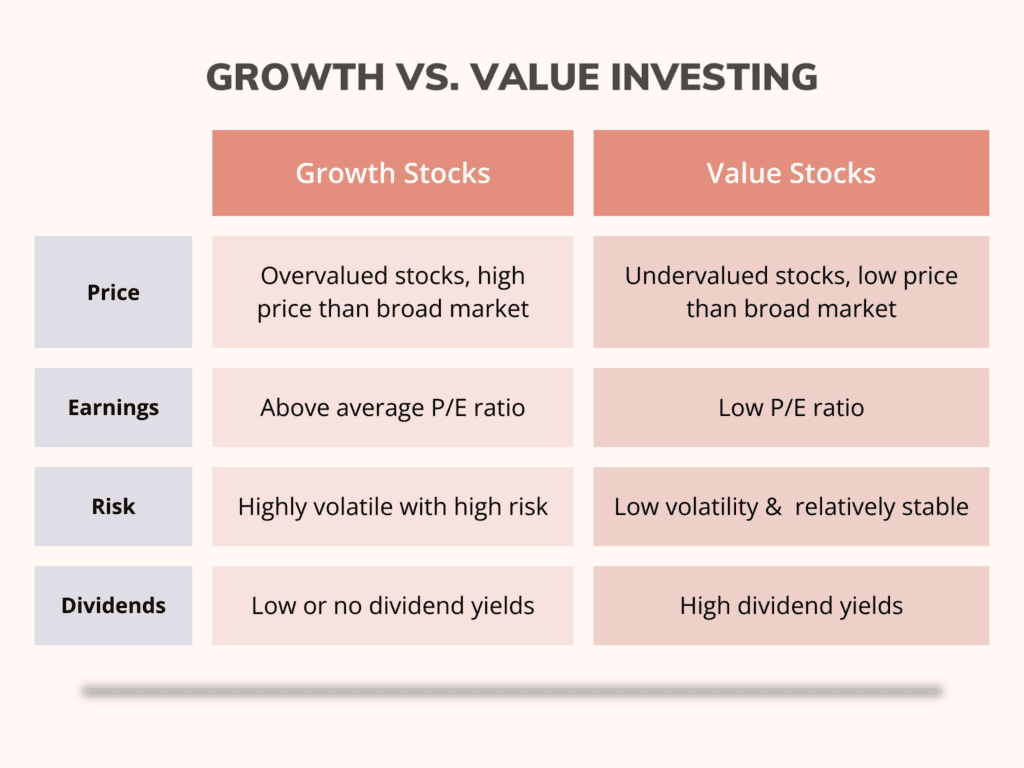
Growth vs Value Investing: How to Choose Between the 2
Have you started your investment journey? Or are you already investing but started investing without any plan? If yes, it’s time to develop your investment plan. Part of this strategy is to choose an investment strategy.
There are several investing strategies to consider, key among them, growth vs value investing. Many successful individual investors often stick to a single investment style. But, if you want, you may use both within your portfolio.
Committing to a single style helps you become consistent. With time, you will develop expertise with your chosen investment style. However, using both styles can help you diversify your portfolio.
The two investing styles reflect the expectations of investors when they purchase stocks. Value investors invest in stocks they believe are undervalued. They expect to benefit when the market price reflects the actual value of the security.
On the other hand, growth investors select stocks intending to achieve above-average returns. In other words, they expect to make more profit from fast growth.
So, which of these investing strategies is best for you? In this article, I will take you through the differences between growth and value investing to help you decide which is better.
Don’t miss this article about DIY Investing: Is This Right For You?
Growth vs Value Investing Explained

Value Investing
Value investing involves searching for stocks that are currently undervalued but have high prospects. Investors who use this style analyze the financial reports of companies to invest in undervalued stocks.
Stocks may appear undervalued for various reasons. The reasons may either be short-term or long-term. For instance, if a well-established company has poor earnings, poor quarterly forecasts, or some other form of bad news, the market may react negatively, reducing the share price in the interim.
Events like this create an entry opportunity for value investors to acquire stocks at a lower price. If you already have shares in the company, a short-term price drop offers you the chance to purchase more. Seizing this chance may reduce your average acquisition price.
Long-term reasons may include market crashes. When markets crash, they often take the prices of most securities down with them. They may take a long time to recover, presenting an opportunity for value investors to purchase undervalued stocks for long-term profit.
Many successful investors use value investing strategies, including Warren Buffett and Benjamin Graham.
Want to invest in shares from Kenyan companies? Here’s Your Beginners Guide to Investing in the Kenyan Stock Market
Growth Investing
This style of investing involves purchasing stocks you expect to outperform the average market. Investors who use this style prefer companies that are yet to reach their full potential. When analysts believe a company has reached its full potential, it ceases to be a growth stock.
Growth investors ignore larger, more established firms and take risks by investing in smaller firms. They believe in high risk and high rewards. When they make accurate predictions, they can make a lot of profit. The ability of growth stocks to change the financial prospects of investors makes them a darling of risk-seeking investors.
Sometimes, a stock may blend the qualities of both growth and value investing. For example, a company may have long-term potential while being undervalued.

Growth vs Value Investing: Which Style Is Better?
Like everything else, there are pros and cons to each style.
Value stocks are less risky than growth stocks because they are often large companies. Many small firms never reach their full potential. As a result, value investing is considerably safer. Even if the share price doesn’t get to the point you had in mind, the risk of failure is lower.
The market capitalization of smaller, fast-growing companies also poses a risk. Because of the smaller capitalization, small firms are more likely to be heavily impacted by negative news.
For example, imagine investing in a pharmaceutical company hoping that its upcoming drug will cure a long-term disease. If the product fails or has terrible side effects, share prices will plummet significantly. Price drops may lead to terrible losses for any investor exposed to the stock.
On the other hand, the stock prices of a larger, more established pharmaceutical company with multiple product lines may survive similar scandals.
Growth stocks are often rapidly growing firms. They often need money for expansion and are more likely to reinvest profits and refuse to pay dividends. If they fail to reach their potential, investors exposed to them will lose their investment without earning any returns from dividend payments.
Value stocks offer small upsides to investors on average. Because they have larger capitalization, the percentage changes in the share prices are often less than that of growth stocks.
Related read: DIY Investing: How To Do It Like a Pro
Growth vs Value Investing: Which Style Should You Adopt?
The decision to invest in value stock or growth stock is yours to make. Your risk tolerance, investment goals, and age are factors you should consider when deciding the investment style to adopt.
If you are younger, you have more time to recoup any money you lose. Therefore, growth stocks may provide better upsides for you in the long term.
If you are older, you have a shorter time to wait for a company to reach its potential. Therefore, your age may make value stocks more appealing to you. On the other hand, you may be better off with more stable companies if you are approaching your retirement age.
However, I recommend working with a financial advisor. A financial advisor is best suited to offer you professional advice to guide your investment decisions.






